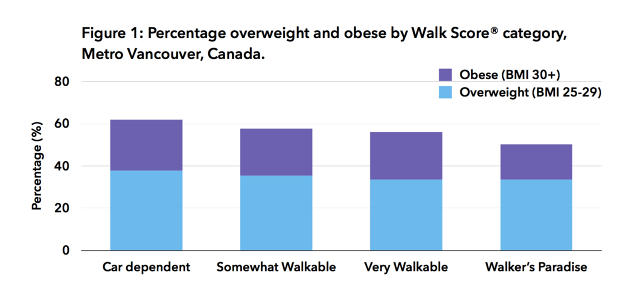Live In A Walkable Neighborhood? You Get To Be Thinner And More Healthy
If you can’t get anywhere without a car, we hate to tell you, but you may be on the road to obesity.
Our health is determined not only by what we eat and how much we exercise, but also by our environment. For example, does your neighborhood encourage walking or cycling to restaurants or stores? Does it make you want to take a stroll after dinner in the evening?
A new study finds a strong correlation between walkability and health outcomes. It shows that adults in walkable cities are 31% less likely to be overweight or obese than people living in car-dependent areas.
Researchers at the Fraser Health Authority, Vancouver Coastal Health, and the University of British Columbia surveyed 28,000 people in the metro area, mostly online. Then they cross-referenced what respondents said about their weight and health with data from Walk Score. People in the second most walkable places (“very walkable”) were 11% less likely to be fat than those in car dependent areas. (Of course, it could be that people who are already more active or health-minded are attracted to the most walkable neighborhoods).

For reference, Walk Score rates Philadelphia, Miami, and Chicago as “very walkable” and Nashville and Jacksonville, Florida, as “car dependent.” But of course that doesn’t apply to every part of each city, and there’s no way of knowing if Vancouver’s patterns would translate elsewhere.
Cities can improve walkability by adding sidewalks, lighting, and safety features, by zoning for cafes and restaurants, and by improving overall ambience. The paper says health should be another consideration when cities get redesigned.
“Walkable neighborhoods may play an important role in prevention of obesity and type 2 diabetes by encouraging active lifestyles and increasing accessibility to services and amenities which promote healthy living,” the authors say. “Planners should view access to walkable neighborhoods not only for community connectedness but as physical activity resources for the community.”
[Top Photo: Hero Images/Getty Images]
Fast Company , Read Full Story
(37)














